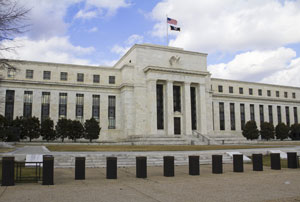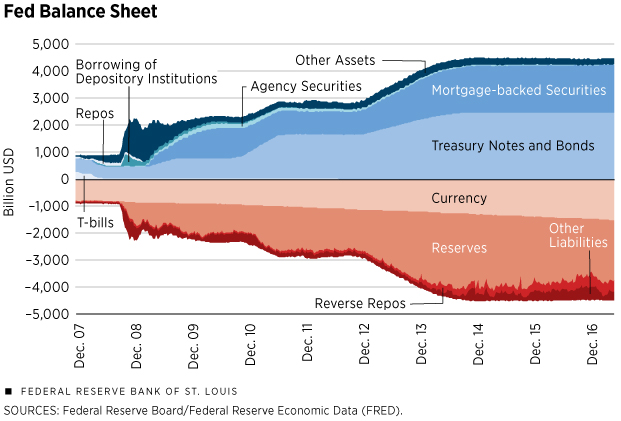What Is Quantitative Easing, and How Has It Been Used?

This is the first post in a three-part series on the use of quantitative easing as a monetary policy tool over the past decade.
During the global financial crisis and the subsequent recovery, many central banks around the world turned to quantitative easing (QE) as a monetary policy tool.
In an article in The Regional Economist, Stephen Williamson, a former vice president and economist at the St. Louis Fed, examined how QE has been used, the theory of how it is supposed to work and whether it has been effective.
What Is QE?
“QE consists of large-scale asset purchases by central banks, usually of long-maturity government debt but also of private assets, such as corporate debt or asset-backed securities,” Williamson explained. “Typically, QE occurs in unconventional circumstances, when short-term nominal interest rates are very low, zero or even negative.”
QE in the U.S.
Williamson noted that the federal funds rate target was zero at the end of 2008, but inflation was below the Fed’s 2 percent target, and output was below potential. With the federal funds rate at the effective lower bound, the Fed resorted to unconventional monetary policy, including several rounds of QE that continued into 2014.
As a result of the QE programs, the Fed’s total assets rose from $882 billion in December 2007 to $4.473 trillion in May 2017.

He also looked at the size of Fed’s balance sheet relative to U.S. gross domestic product (GDP). In the fourth quarter of 2007, the Fed’s balance sheet was 6.0 percent of GDP, but it had grown to 23.5 percent of GDP in the first quarter of 2017.
QE among Other Central Banks
Other central banks have used QE since the crisis—some in an even bigger way than the Fed, Williamson said. He noted that in December 2016:
- The Bank of Japan’s balance sheet was 88 percent of GDP.
- Switzerland’s was 115 percent of GDP.
- The Swedish Riksbank’s was 19 percent of GDP.
- The Bank of England’s was 24 percent of GDP.
- The European Central Bank’s was 34 percent of GDP.
“In essentially all of the QE programs conducted in the world during and after the financial crisis, central banks seemed primarily interested in how the type and quantity of asset purchases would affect financial market conditions and, ultimately, inflation and aggregate economic activity,” he wrote.
The next post in this series will discuss the typical justification for QE and how QE is supposed to work in theory.
Follow the Series
- What Is Quantitative Easing, and How Has It Been Used?
- What Economic Theory Says about Quantitative Easing
- Does Quantitative Easing Work as Advertised?
Additional Resources
- Regional Economist: Quantitative Easing: How Well Does This Tool Work?
- On the Economy: What Does Neo-Fisherism Say about Unconventional Monetary Policy?
- On the Economy: How Might Increases in the Fed Funds Rate Impact Other Interest Rates?
This blog offers commentary, analysis and data from our economists and experts. Views expressed are not necessarily those of the St. Louis Fed or Federal Reserve System.
Email Us
All other blog-related questions


